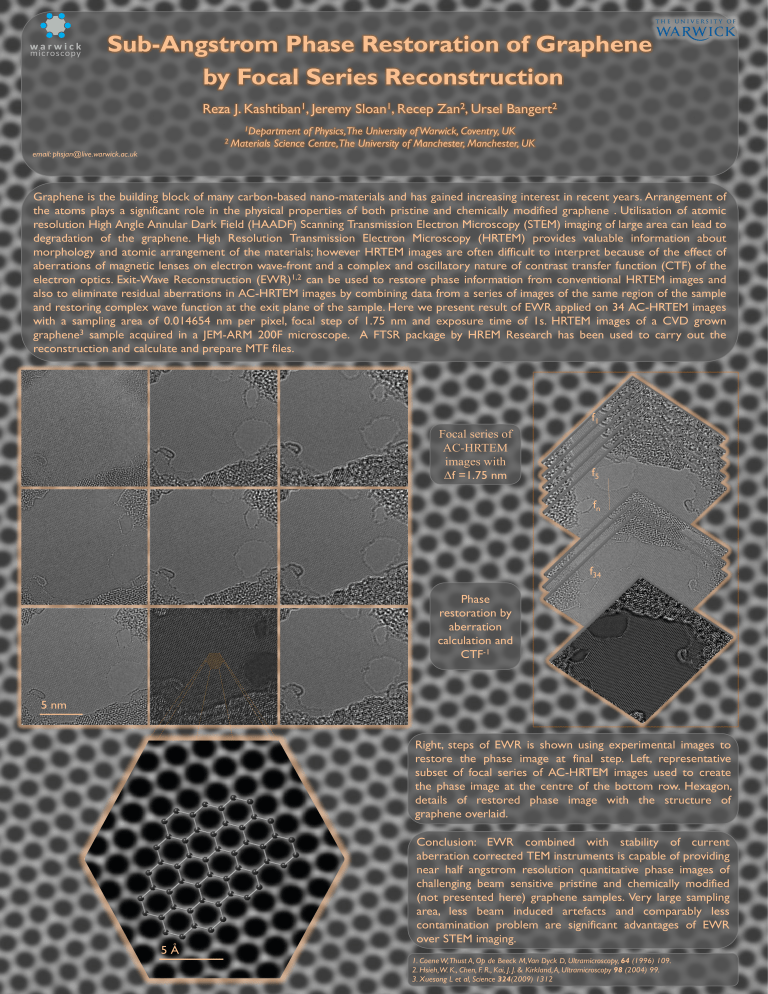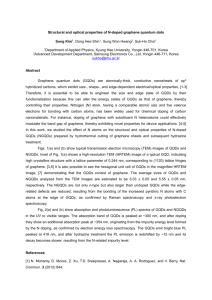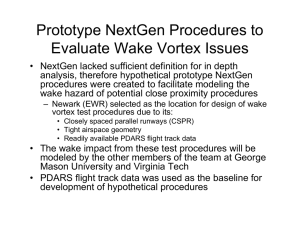Sub-Angstrom Phase Restoration of Graphene by Focal Series Reconstruction Reza J. Kashtiban

Sub-Angstrom Phase Restoration of Graphene
by Focal Series Reconstruction
Reza J. Kashtiban
1
, Jeremy Sloan
1
, Recep Zan
2
, Ursel Bangert
2
1
Department of Physics, The University of Warwick, Coventry, UK
2
Materials Science Centre, The University of Manchester, Manchester, UK
email: phsjan@live.warwick.ac.uk
Graphene is the building block of many carbon-based nano-materials and has gained increasing interest in recent years. Arrangement of the atoms plays a significant role in the physical properties of both pristine and chemically modified graphene . Utilisation of atomic resolution High Angle Annular Dark Field (HAADF) Scanning Transmission Electron Microscopy (STEM) imaging of large area can lead to degradation of the graphene. High Resolution Transmission Electron Microscopy (HRTEM) provides valuable information about morphology and atomic arrangement of the materials; however HRTEM images are often difficult to interpret because of the effect of aberrations of magnetic lenses on electron wave-front and a complex and oscillatory nature of contrast transfer function (CTF) of the electron optics. Exit-Wave Reconstruction (EWR) 1,2 can be used to restore phase information from conventional HRTEM images and also to eliminate residual aberrations in AC-HRTEM images by combining data from a series of images of the same region of the sample and restoring complex wave function at the exit plane of the sample. Here we present result of EWR applied on 34 AC-HRTEM images with a sampling area of 0.014654 nm per pixel, focal step of 1.75 nm and exposure time of 1s. HRTEM images of a CVD grown graphene 3 sample acquired in a JEM-ARM 200F microscope. A FTSR package by HREM Research has been used to carry out the reconstruction and calculate and prepare MTF files.
Focal series of
AC-HRTEM images with
Δ
f =1.75 nm f
1 f
5 f n f
34
Phase restoration by aberration calculation and
CTF -1
5 nm
5 Å
Right, steps of EWR is shown using experimental images to restore the phase image at final step. Left, representative subset of focal series of AC-HRTEM images used to create the phase image at the centre of the bottom row. Hexagon, details of restored phase image with the structure of graphene overlaid.
Conclusion: EWR combined with stability of current aberration corrected TEM instruments is capable of providing near half angstrom resolution quantitative phase images of challenging beam sensitive pristine and chemically modified
(not presented here) graphene samples. Very large sampling area, less beam induced artefacts and comparably less contamination problem are significant advantages of EWR over STEM imaging.
1. Coene W, Thust A, Op de Beeck M, Van Dyck D, Ultramicroscopy, 64 (1996) 109.
2. Hsieh, W. K., Chen, F. R., Kai, J. J. & Kirkland, A, Ultramicroscopy 98 (2004) 99.
3. Xuesong L et al, Science 324 (2009) 1312





